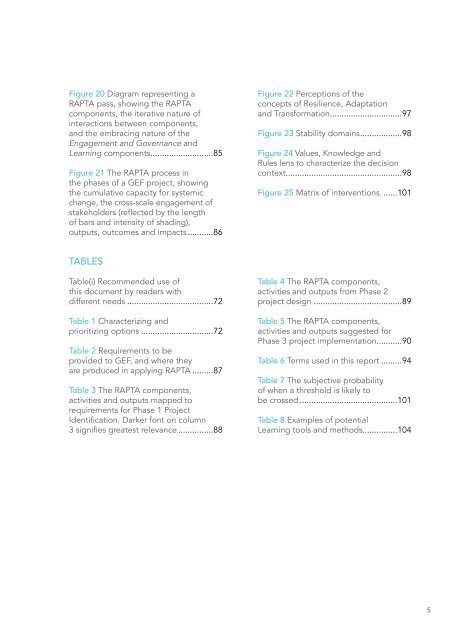DESIGNING PROJECTS IN A RAPIDLY CHANGING WORLD
srun3013fp1
srun3013fp1
You also want an ePaper? Increase the reach of your titles
YUMPU automatically turns print PDFs into web optimized ePapers that Google loves.
Figure 20 Diagram representing a<br />
RAPTA pass, showing the RAPTA<br />
components, the iterative nature of<br />
interactions between components,<br />
and the embracing nature of the<br />
Engagement and Governance and<br />
Learning components............................85<br />
Figure 21 The RAPTA process in<br />
the phases of a GEF project, showing<br />
the cumulative capacity for systemic<br />
change, the cross-scale engagement of<br />
stakeholders (reflected by the length<br />
of bars and intensity of shading),<br />
outputs, outcomes and impacts............86<br />
Figure 22 Perceptions of the<br />
concepts of Resilience, Adaptation<br />
and Transformation................................97<br />
Figure 23 Stability domains...................98<br />
Figure 24 Values, Knowledge and<br />
Rules lens to characterize the decision<br />
context...................................................98<br />
Figure 25 Matrix of interventions........101<br />
TABLES<br />
Table(i) Recommended use of<br />
this document by readers with<br />
different needs......................................72<br />
Table 1 Characterizing and<br />
prioritizing options................................72<br />
Table 2 Requirements to be<br />
provided to GEF, and where they<br />
are produced in applying RAPTA..........87<br />
Table 3 The RAPTA components,<br />
activities and outputs mapped to<br />
requirements for Phase 1 Project<br />
Identification. Darker font on column<br />
3 signifies greatest relevance................88<br />
Table 4 The RAPTA components,<br />
activities and outputs from Phase 2<br />
project design.......................................89<br />
Table 5 The RAPTA components,<br />
activities and outputs suggested for<br />
Phase 3 project implementation...........90<br />
Table 6 Terms used in this report..........94<br />
Table 7 The subjective probability<br />
of when a threshold is likely to<br />
be crossed...........................................101<br />
Table 8 Examples of potential<br />
Learning tools and methods...............104<br />
5


